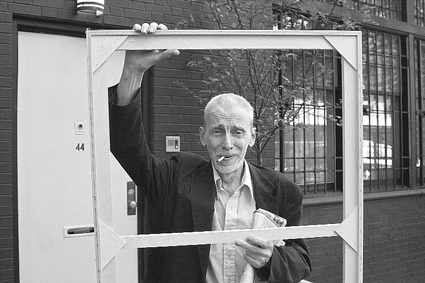By Sara G. Levin
Bill Rice, who died on Jan. 23 at 74 from lung cancer, was perhaps best known as a legendary underground actor who appeared in “Coffee and Cigarettes” with Taylor Mead. But he was first and foremost a painter, then a photographer, sculptor, filmmaker and historian, who was a fixture in the avant-garde art world for over 30 years. He died at Cabrini Medical Center on E. Fifth St. after a month’s stay there.
“[Bill] was so in love with art and anybody who was doing anything — writing, painting, acting,” said friend Larry Mitchell, a writer. “So many people would come up to him in The Bar [his hangout on Second Ave.],” Mitchell described, explaining how Rice used to connect and foster young artists.
Born in Vermont in 1931, Rice attended Middlebury College for painting and moved to Bank St. in the Village in 1953. After settling into a tenement studio on E. Third St. seven years later, he began experimenting with different media and forms of expression.
“The 1970s were a misery… There was nothing there at all — except disco,” Rice said in an interview with Clayton Patterson, editor of “Captured: A Film/Video History of the Lower East Side.” But then he added, “A friend of mine cast me in a play [“Raisin Pie and the Hermaphroditic Umbrella” by Gabriel Oshen]. So I can’t really say that nothing happened in the 1970s to me. That was the beginning of a very good time.”
Rice was involved in numerous theatric productions with Jim Neu and Gary Indiana, moving on to do experimental films with Scott and Beth B, Jacob Burckhardt, Jim Jarmusch, Gary Goldberg, Amos Poe and Robert Frank.
In a 2004 New York magazine article Indiana wrote, “When I moved into the neighborhood in the late seventies I immediately assembled a theater troupe with the actor and painter Bill Rice, a slyboots sage revered in the authentic New York bohemia since Harry Truman.”
“It was always good to put the camera on [Rice] because it was interesting to look at him,” filmmaker Frank said. Rice had worked in Frank’s “Last Supper.” “It was his demeanor and he could change his face slightly and it was a totally different look,” Frank said.
“He was very Vermont,” said Mead, who starred in several film shorts with Rice. “He was reticent, rather stoic. I’m kind of volatile. In fact he helped calm me down.” One of their shorts, “Plates,” involved Rice stacking kitchen plates before Mead’s pants fell down and he smashed all the plates to the ground.
As Rice continued acting, he showed his work at the Brooklyn Terminal Arts Show in 1983 and began receiving recognition for his paintings. During that period he hosted at his studio a mix of artists, like Barbara Ess, Richard Morrison, Mark Tambella and Francie Lyshak, and referred to his studio as the “Saloon Salon.” His last art show, “The View from 13 East 3rd,” was organized by Francie Lyshak and Steven Harvey for the Mitchell Algus Gallery last fall in Chelsea.
Although Algus still has some of Rice’s works, longtime friends Morrison and Leo Miles Jones also have paintings of his that they hope can be sold. All proceeds from his work will go to Rice’s partner of nearly 20 years, Michael Cobarubias, according to Morrison, who is overseeing the execution of his will. Rice is also survived by a half-brother, Edward Baumgardner, of Oneonta, NY.
“Bill was an [openly] gay man before gay liberation,” said Morrison admiringly. “[He] was out in the ’50s and never made any secret about it.”
Many of Rice’s paintings were homoerotic, and according to Morrison, the 2,000 pages of notes he left behind about Picasso were part of Rice’s mission to prove that the painting “Desmoiselles d’Avignon” was originally based on men.
During a period of 20 years Rice helped scholar Ulla E. Dydo sift through original notebooks by Gertrude Stein to compile “A Stein Reader,” published in 1993, and “Gertrude Stein: The Language That Rises, 1923-1934,” published in 2003.
He was inspired to delve into Stein’s history while helping Ed Burns, an English professor, edit a volume of her letters.
In an essay Burns wrote for one of Rice’s exhibits, Rice said, “In paintings, I am interested in what happens around the corner of the surface. Ideally, I would like to invest the rectangle — the basic unit in any cityscape — with the sensuality, color, texture, I find in the streets. I like to record the young, elegant, black, Asian and Hispanic men who know how to move and glow in what would otherwise be a dreary landscape.” Rice also collaborated with writers Rene Ricard and David Wojnarowicz.
Continuing to work right up until the end, Rice spent the last year of his life fighting his disease while completing drawings and illustrations for a new book by Nemo Hill called “The Pottery Twins.”
His remains were cremated and his ashes spread in different places, including Paris, in honor of Picasso. A memorial service is being planned at one of the La MaMa Theater spaces, where he gave many performances, though a date has not been set.
































